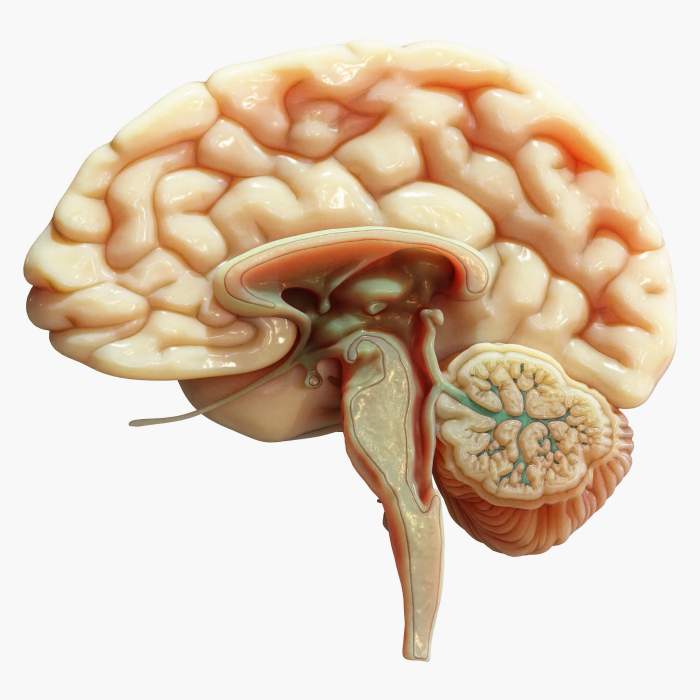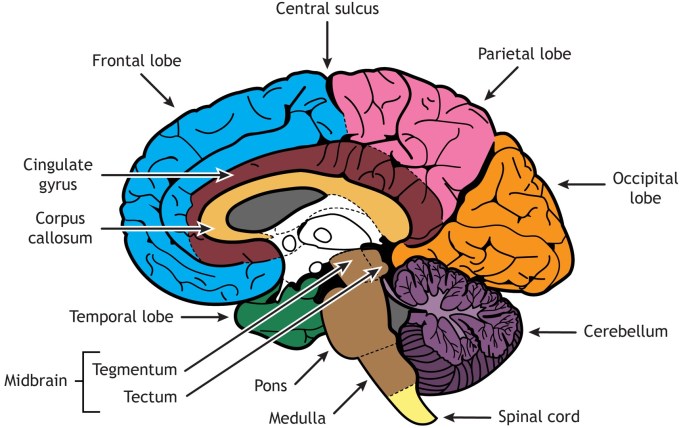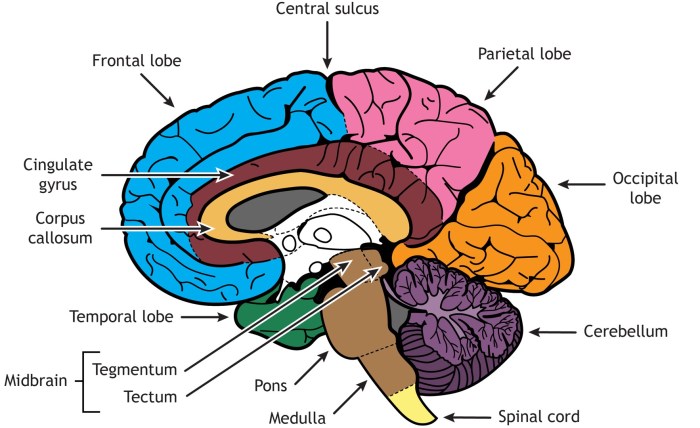Reward system in brain governs our motivations, desires, and even addictions. This intricate network of brain regions, including the nucleus accumbens and the prefrontal cortex, plays a crucial role in shaping our actions and experiences. From the simple pleasure of eating to the complex drive to connect with others, this system is at the heart of our existence.
We’ll delve into the neurobiological mechanisms behind reward, exploring the intricate pathways involving dopamine and other neurotransmitters. We’ll also examine how the reward system influences learning, motivation, and even addictive behaviors. Understanding the reward system in the brain is key to appreciating the complexities of human behavior and well-being.
Neurobiological Mechanisms of Reward
The brain’s reward system is a complex network intricately woven into our motivations and behaviors. It drives us to seek out things that are beneficial for survival, from finding food to forging social connections. Understanding its underlying neurobiological mechanisms is crucial for comprehending our actions and responses to various stimuli.
Fundamental Neurobiological Processes in Reward
The reward system is not a singular structure but a network of interconnected brain regions that work in concert to process and respond to rewarding stimuli. This network’s core function is to motivate behavior, encouraging us to repeat actions that lead to pleasure or satisfaction. The fundamental process involves the anticipation, experience, and memory of reward. This process triggers a cascade of neurobiological events, ultimately shaping our actions and preferences.
Key Brain Regions and Neural Pathways
Central to the reward system is the mesolimbic pathway, a crucial neural circuit that plays a vital role in processing reward. This pathway connects the ventral tegmental area (VTA) to the nucleus accumbens (NAc), with dopamine as its primary neurotransmitter. The VTA acts as a central reward center, releasing dopamine when a rewarding stimulus is encountered. This dopamine release then signals the NAc, which is involved in the experience of pleasure and motivation.
The amygdala, hippocampus, and prefrontal cortex also contribute significantly to the reward process, influencing emotional responses, memory formation, and decision-making associated with rewards.
Different Types of Rewards
Different types of rewards, despite their diverse nature, share common neurobiological underpinnings. Food, social interaction, and monetary gain, while distinct in their experience, all trigger similar neural responses, culminating in dopamine release in the reward pathway. For instance, the anticipation of a delicious meal activates the same reward circuitry as the anticipation of social acceptance or a financial gain.
The specific brain regions and neural pathways engaged might vary slightly depending on the type of reward, but the core mechanisms remain largely consistent.
Role of Hormones and Neurotransmitters
The reward system’s function is intricately modulated by various hormones and neurotransmitters. Dopamine, as mentioned earlier, is pivotal in signaling reward, but other neurochemicals like serotonin, norepinephrine, and endorphins also play crucial roles. For example, serotonin impacts the emotional valence of a reward, while endorphins contribute to the feelings of euphoria associated with some rewards. Hormones like cortisol and testosterone can also influence reward responses, impacting motivation and drive in different contexts.
Summary Table of Brain Regions and their Roles
| Region | Function | Neurotransmitters | Examples |
|---|---|---|---|
| Ventral Tegmental Area (VTA) | Initiates dopamine release in response to reward | Dopamine | Anticipation of a tasty meal, prospect of a social interaction |
| Nucleus Accumbens (NAc) | Processes reward experience, motivation | Dopamine, glutamate | Experience of pleasure from a tasty meal, social bonding |
| Amygdala | Processes emotional aspects of reward | Dopamine, norepinephrine, serotonin | Fear, anxiety related to reward or lack of reward |
| Hippocampus | Forms memories associated with reward | Acetylcholine, glutamate | Remembering past experiences associated with a specific reward |
| Prefrontal Cortex | Decision-making, planning, and control related to reward | Dopamine, glutamate | Deciding what reward to prioritize, planning for a reward |
Reward System and Learning
The reward system, deeply intertwined with our survival and well-being, plays a crucial role in shaping our learning processes. From the simple act of reaching for food to the complex pursuit of a career goal, rewards motivate us to repeat actions that lead to positive outcomes. This intricate relationship between reward and learning is fundamental to understanding human behavior and the development of habits.Understanding how reward signals influence the formation of associations and memories is key to comprehending how we learn.
The reward system, primarily centered in the brain’s limbic system, operates as a motivational engine, driving us to seek out pleasurable experiences and avoid unpleasant ones. This process involves intricate neural pathways and neurochemical cascades that are constantly being refined through experience.
Relationship between Reward and Learning
The reward system is deeply embedded within learning processes. Reward signals, often represented by dopamine release in the nucleus accumbens, act as crucial feedback mechanisms, strengthening neural connections associated with rewarding experiences. These signals essentially reinforce the behaviors that led to those experiences, increasing the likelihood of their repetition.
How Reward Signals Influence Associations and Memories
Reward signals are not merely pleasurable sensations; they act as powerful tools for shaping associations and memories. When a particular behavior is followed by a reward, the brain strengthens the neural pathways involved. This strengthening process, known as long-term potentiation, creates a more efficient and robust memory trace. The more frequently a behavior is rewarded, the stronger the association becomes, leading to a more ingrained habit.
For instance, a child learning to ride a bicycle repeatedly receives the reward of successfully navigating the bike. Over time, the neural connections associated with this activity become stronger, and the child’s memory and skill improve.
Role of Reinforcement Learning in Shaping Behavior
Reinforcement learning is a crucial aspect of how the reward system shapes behavior. In this framework, actions are performed in anticipation of a reward. The reward signals then provide feedback, adjusting the future likelihood of similar actions. This continuous feedback loop is essential for adapting to changing environments and optimizing behavior for maximal reward. For example, a dog learns to sit on command through positive reinforcement.
The reward of praise or a treat strengthens the neural pathways associated with the behavior, making it more likely to occur again.
Comparison of Classical and Operant Conditioning
Classical and operant conditioning are two fundamental learning mechanisms that rely on reward processing in different ways. Classical conditioning, exemplified by Pavlov’s dogs, involves associating a neutral stimulus with a rewarding stimulus. Over time, the neutral stimulus elicits a similar response as the reward stimulus. Operant conditioning, in contrast, involves learning through consequences. A behavior followed by a reward is strengthened, while a behavior followed by a punishment is weakened.
Both types of conditioning rely on the reward system to shape associations and memories, but they differ in the nature of the stimulus-response relationship.
Learning Mechanisms and Reward
| Mechanism | Reward Type | Brain Region | Impact |
|---|---|---|---|
| Classical Conditioning | Unconditioned stimulus associated with a neutral stimulus | Amygdala, hippocampus | Formation of associations, learned responses |
| Operant Conditioning | Positive reinforcement (reward) or punishment | Nucleus accumbens, prefrontal cortex | Strengthening or weakening of behaviors, habit formation |
| Instrumental Learning | Reward contingent on specific action | Striatum, basal ganglia | Goal-directed behavior, problem-solving |
| Observational Learning | Vicarious reward from observing others | Mirror neurons, prefrontal cortex | Learning new behaviors without direct experience |
Reward System and Motivation
The reward system, a complex network in the brain, is far more than just a pleasure center. It’s deeply intertwined with our motivation, influencing our decisions, behaviors, and even our long-term goals. Understanding the intricate mechanisms behind this system reveals the driving forces behind our actions and choices. This crucial interplay between reward and motivation is pivotal for comprehending human behavior.The reward system doesn’t simply react to a reward; it anticipates and predicts it.
This anticipation, fueled by past experiences and learned associations, profoundly shapes our motivation. Anticipation of a positive outcome is a potent motivator, driving us to engage in actions that increase the likelihood of obtaining that reward.
Mechanisms of Reward System Influence on Motivation
The reward system’s influence on motivation stems from its intricate connection to learning and prediction. Dopamine, a key neurotransmitter in this system, plays a crucial role in signaling reward prediction errors. These errors, the difference between expected and actual reward, are critical for learning and adapting our behaviors to maximize future rewards. A positive prediction error, for instance, strengthens the neural pathways associated with a particular action, making us more likely to repeat it.
Role of Anticipation and Prediction Errors in Driving Motivation
Anticipation of a reward, even in the absence of an immediate reward, is a powerful motivator. Imagine the excitement of waiting for a birthday present or the anticipation of a delicious meal. These feelings are directly linked to the brain’s reward system. Prediction errors, the discrepancy between the anticipated reward and the actual outcome, are fundamental in shaping our motivation.
A prediction error reinforces the neural pathways associated with obtaining a reward, further driving motivation. For example, if you anticipate a larger reward than you actually receive, the prediction error adjusts your future expectations and behaviors.
Interplay Between Reward Anticipation and Behavior
The interplay between reward anticipation and behavior is a dynamic process. Anticipation activates specific brain regions, such as the prefrontal cortex and the nucleus accumbens, preparing us for action. This anticipation is often accompanied by physiological changes, such as increased heart rate or heightened attention. These changes reflect the brain’s preparedness to pursue a rewarding goal. In turn, successful attainment of a reward reinforces the anticipatory processes, leading to stronger motivation for similar actions in the future.
For example, a student anticipating a good grade will study more diligently, and achieving that good grade reinforces the anticipation and study habits.
Examples of How Reward Systems Influence Goal-Directed Behaviors
The reward system is crucial in motivating goal-directed behaviors. Consider the pursuit of a desired career. The anticipation of job satisfaction, recognition, and financial stability activates the reward system, driving the individual to pursue education and training. Likewise, the desire for social connection is another powerful motivator, driven by the anticipation of positive social interactions and the subsequent release of dopamine.
Motivational States and Their Neural Correlates
| Motivational State | Neurotransmitters | Brain Region | Behavioral Response |
|---|---|---|---|
| Hunger | Ghrelin, Leptin, Neuropeptide Y | Hypothalamus, Amygdala | Food seeking and consumption |
| Thirst | Vasopressin, Angiotensin II | Hypothalamus, Nucleus Accumbens | Water seeking and consumption |
| Fear | Norepinephrine, Cortisol | Amygdala, Prefrontal Cortex | Flight or fight response |
| Sexual Motivation | Testosterone, Estrogen, Dopamine | Hypothalamus, Amygdala, Nucleus Accumbens | Mate seeking and sexual behavior |
| Social Motivation | Oxytocin, Dopamine | Prefrontal Cortex, Orbitofrontal Cortex | Social interaction and bonding |
Reward System and Addiction
The brain’s reward system, a complex network of neural pathways, plays a crucial role in motivation, learning, and pleasure. It’s designed to reinforce behaviors that are vital for survival, such as eating, drinking, and social interaction. However, this same system can be hijacked by addictive substances, leading to compulsive behaviors and devastating consequences. Understanding the dysregulation of this system in addiction is key to developing effective prevention and treatment strategies.The reward system is not simply a pleasure center; it’s a highly intricate network of interacting brain regions, primarily including the ventral tegmental area (VTA), nucleus accumbens (NAc), and prefrontal cortex (PFC).
These regions are interconnected through complex pathways that involve neurotransmitters like dopamine. This intricate system, when functioning normally, promotes healthy behaviors, but when dysregulated, it can drive individuals towards addictive substances and compulsive behaviors.
Dysregulation of the Reward System in Addictive Behaviors
Addictive substances and behaviors dramatically alter the brain’s reward circuitry, leading to a cascade of changes that make it extremely difficult to stop the compulsive behaviors. This dysregulation is characterized by an exaggerated response to the addictive substance or behavior, a reduced response to natural rewards, and a heightened craving for the addictive stimulus. This altered reward system makes it challenging for individuals to experience pleasure from activities not related to the addiction, while the addictive stimulus becomes hyper-rewarding, leading to an overwhelming compulsion to repeat the behavior.
Ever wondered how our brains reward us for good behavior? It’s a fascinating system, wired to motivate us. Interestingly, people in some of the healthiest states in the USA ( the healthiest states the usa ) might experience this reward system differently, perhaps due to factors like access to healthy food and lower stress levels. Regardless, understanding this intricate reward system is key to a healthier lifestyle overall.
How Drugs of Abuse Hijack the Reward System
Drugs of abuse exploit the brain’s natural reward pathways, triggering a surge of dopamine release in the nucleus accumbens. This intense dopamine release reinforces the behavior associated with drug use, making it highly rewarding and ultimately leading to addiction. The initial pleasurable effects act as a powerful reinforcer, quickly creating a cycle of dependence. Different drugs achieve this hijacking through various mechanisms, each influencing the dopamine system differently.
Comparison of Effects of Addictive Substances
Different addictive substances have varying effects on the brain’s reward circuitry. While all can trigger dopamine release, the specific pathways and regions impacted differ. For instance, opioids directly interact with opioid receptors, leading to a rapid and intense dopamine release. Cocaine, on the other hand, blocks dopamine reuptake, prolonging the dopamine signal in the synapse. These differences in mechanisms explain the diverse range of symptoms and consequences associated with different addictions.
Environmental Factors Influencing Vulnerability to Addiction
Environmental factors play a significant role in determining an individual’s vulnerability to addiction. Exposure to stressful life events, social pressures, and the presence of addictive substances in the environment can all increase the risk of developing addiction. The interplay between genetic predisposition and environmental factors is crucial in understanding the complex etiology of addiction. For example, growing up in a household where substance use is common or where mental health challenges are prevalent can significantly increase a person’s risk.
Neural Mechanisms Underlying Compulsive Drug Use
Compulsive drug use is characterized by a profound shift in the brain’s reward system. The initial pleasure-seeking behavior becomes compulsive, driven by intense cravings and urges. The prefrontal cortex, responsible for executive functions and decision-making, becomes impaired, further contributing to the loss of control over drug-seeking behavior. This impaired executive control is often associated with long-term changes in the brain’s neural circuitry, including reduced grey matter volume in certain regions.
Effects of Addictive Substances on Dopamine Release and Brain Regions
| Substance | Dopamine Effect | Brain Region | Behavioral Consequence |
|---|---|---|---|
| Cocaine | Blocks dopamine reuptake | Nucleus accumbens, prefrontal cortex | Euphoria, increased alertness, agitation |
| Opioids | Increases dopamine release indirectly | Nucleus accumbens, amygdala | Analgesia, euphoria, respiratory depression |
| Alcohol | Increases and then decreases dopamine release | Nucleus accumbens, hippocampus | Impaired judgment, mood swings, memory problems |
| Nicotine | Increases dopamine release | Nucleus accumbens, amygdala | Relaxation, arousal, increased attention |
Individual Differences in Reward Processing: Reward System In Brain

Our brains are wired to seek rewards, but the intensity of that drive and how we respond to different rewards varies significantly from person to person. Understanding these individual differences is crucial for comprehending everything from healthy motivation to the development of addictive behaviors and mental health conditions. This exploration delves into the multifaceted factors influencing how individuals experience and react to rewards.Reward sensitivity, a core component of this variability, reflects the strength of our motivational drive for rewards.
Some individuals are highly sensitive, readily drawn to potential rewards and experiencing a potent emotional response. Others may be less sensitive, requiring a larger incentive or a more pronounced reward experience to trigger a comparable response. These variations stem from a complex interplay of genetic predispositions and environmental influences.
Our brains have a fascinating reward system, wired to motivate us towards pleasurable experiences. Think about how satisfying a delicious meal can be. That’s the reward system in action! Interestingly, incorporating amazing benefits of lemongrass refreshing recipes amazing benefits of lemongrass refreshing recipes into your diet can positively impact this system. The fresh, zesty flavours may trigger similar pleasurable responses, potentially influencing your brain’s reward circuitry in a positive way.
Ultimately, understanding and nurturing our reward systems is key to overall well-being.
Genetic Influences on Reward Processing
Genetic factors play a significant role in shaping individual differences in reward processing. Specific genes influence the activity of neurotransmitter systems, like dopamine, which are intimately involved in reward pathways. Variations in these genes can affect the sensitivity of receptors in the brain’s reward circuitry, leading to differing responses to rewarding stimuli. For instance, variations in dopamine receptor genes have been linked to differences in reward-seeking behavior, impacting how individuals pursue and experience pleasure.
These genetic predispositions, however, do not dictate destiny; environmental factors can interact with these genes, influencing the expression of these traits.
Experiential Influences on Reward Processing
Experiences throughout life significantly shape how individuals process rewards. Early childhood experiences, particularly those involving consistent positive reinforcement or adverse events, can mold the brain’s reward circuitry. Learned associations, where certain stimuli are consistently paired with rewards, can influence how individuals react to similar stimuli in the future. Exposure to stressful environments or traumatic events can alter the sensitivity of the reward system, potentially leading to heightened or diminished responses to rewards.
For example, a child consistently praised for effort and achievement may develop a strong association between positive outcomes and their actions, fostering a more motivated approach to future tasks. Conversely, a child experiencing neglect or abuse might develop a diminished sensitivity to rewards or a distorted perception of their value.
Personality Traits and Reward Processing
Personality traits are also linked to individual differences in reward processing. Individuals high in neuroticism might be more sensitive to negative outcomes and less tolerant of uncertainty, potentially leading to heightened anxiety in situations involving reward anticipation. Conversely, individuals high in extraversion might be more driven by social rewards and more readily seek out novel experiences, impacting their reward processing in social contexts.
Furthermore, conscientiousness, characterized by a focus on achievement and planning, can influence the anticipation and pursuit of rewards that are tied to long-term goals.
Reward Sensitivity and Mental Health
Reward sensitivity is intricately linked to several mental health conditions. Individuals with heightened reward sensitivity may be more vulnerable to developing addictive behaviors, as they are more easily drawn to the immediate gratification offered by substances or activities. Conversely, reduced reward sensitivity may be associated with conditions like depression, where the motivation to engage in rewarding activities is diminished.
Research consistently shows that individuals with anxiety disorders often display heightened sensitivity to potential negative outcomes, which can impact their perception and processing of reward. This illustrates how reward processing interacts with the broader psychological landscape.
Ever wondered what drives some to succeed while others struggle? It boils down to how our brains process rewards. A well-functioning reward system in the brain encourages positive habits and motivates us to pursue goals. This directly relates to the habits that differentiate successful people from unsuccessful people, like the ones explored in this fascinating article about successful people unsuccessful people the habits that differentiate them.
Understanding how our brains react to different stimuli, and how to leverage that for positive reinforcement, is crucial for personal growth and achievement. Ultimately, it’s all about maximizing the brain’s reward system for optimal results.
Stress and Environmental Factors
Stressful life events and environmental factors significantly influence individual reward processing. Chronic stress can alter the functioning of neurotransmitter systems, leading to changes in reward sensitivity. Exposure to stressful environments can lead to heightened anxiety, potentially affecting how individuals perceive and respond to rewards. For instance, individuals facing prolonged financial hardship may show a diminished response to potential rewards related to material wealth, while conversely, they might show increased reward sensitivity to rewards that represent safety and security.
Environmental factors like socioeconomic status, access to resources, and social support networks can also shape individual responses to rewards.
| Factor | Mechanism | Impact | Example |
|---|---|---|---|
| Genetics | Variations in genes influencing neurotransmitter systems (e.g., dopamine) | Increased or decreased sensitivity to rewards, impacting motivation and response | Individuals with variations in dopamine receptor genes may exhibit different levels of reward-seeking behavior. |
| Experience | Early childhood experiences, learned associations, and exposure to stress | Alterations in brain’s reward circuitry, shaping individual responses to rewards | A child consistently praised for effort may develop a stronger association between positive outcomes and their actions. |
| Personality | Traits like neuroticism, extraversion, and conscientiousness | Influence how individuals perceive and respond to rewards, impacting motivation and behavior | Individuals high in neuroticism might be more sensitive to negative outcomes, impacting reward anticipation. |
| Mental Health | Conditions like depression, anxiety, and addiction | Alterations in reward processing, impacting motivation, behavior, and well-being | Individuals with anxiety disorders may show heightened sensitivity to potential negative outcomes, influencing reward perception. |
| Stress | Chronic stress and environmental factors | Changes in neurotransmitter systems, impacting reward sensitivity and response | Prolonged financial hardship may lead to diminished response to material wealth rewards, while increasing sensitivity to rewards related to safety and security. |
Reward System and Social Behavior
The human brain is wired for connection. Social interaction is fundamental to our survival and well-being, and a crucial part of this drive is the intricate reward system. It’s not just about the immediate gratification of food or shelter; social bonds and interactions trigger a cascade of neurochemical reactions that contribute to our overall happiness and sense of belonging.
This system, far from being a simple circuit, is deeply involved in shaping our social behavior and impacting our emotional landscape.
The Role of the Reward System in Social Interactions
The reward system plays a multifaceted role in social interactions, motivating us to seek out and maintain relationships. Dopamine, a key neurotransmitter in the reward pathway, is released during positive social experiences, reinforcing the behaviors associated with those experiences. This reinforcement is crucial for the development of social bonds and the maintenance of healthy relationships. The anticipation of social interaction can also activate the reward system, creating a sense of excitement and anticipation.
Neural Mechanisms Underlying Social Reward and Bonding
The neural circuitry underlying social reward is complex and multifaceted. Several brain regions, including the ventral tegmental area (VTA), nucleus accumbens (NAc), and prefrontal cortex (PFC), are crucial in processing social rewards. The VTA, acting as a sort of reward center, releases dopamine, which then activates the NAc, contributing to the pleasurable feelings associated with social connection. The PFC plays a vital role in evaluating and interpreting social cues, further shaping our response to social interactions.
Oxytocin, another crucial hormone, is associated with feelings of trust, attachment, and bonding, further strengthening social connections. Oxytocin’s role in pair bonding is well documented in animal studies.
Connection Between Social Reward and Prosocial Behaviors
Positive social experiences activate the reward system, leading to feelings of pleasure and well-being. This positive reinforcement can motivate prosocial behaviors, such as altruism, cooperation, and empathy. Individuals experiencing a strong sense of social reward are often more likely to engage in actions that benefit others. The satisfaction derived from helping others can further reinforce prosocial behavior.
How Social Exclusion Impacts the Reward System, Reward system in brain
Social exclusion, a common human experience, has a profound impact on the reward system. Studies have shown that social exclusion can activate similar neural pathways to physical pain. The experience of being ostracized or excluded can trigger a release of stress hormones, reducing dopamine levels, and leading to feelings of sadness, anxiety, and even depression. This highlights the profound importance of social connection for our overall well-being.
Examples of Social Interactions That Activate the Reward System
Numerous social interactions can activate the reward system. These include:
- Spending time with loved ones: Sharing laughter, engaging in meaningful conversations, and enjoying shared activities all trigger the release of dopamine and other neurochemicals associated with reward.
- Receiving social support: Feeling understood and cared for by others can be profoundly rewarding, activating the reward pathways.
- Achieving a shared goal with a friend or team member: The sense of accomplishment and teamwork activates the reward system.
- Receiving positive feedback from peers: Compliments and praise from others can trigger a release of dopamine, reinforcing positive social interactions.
Comparison of Social Reward and Other Types of Reward
| Reward Type | Neurotransmitters | Brain Region | Behavioral Response |
|---|---|---|---|
| Social Reward | Dopamine, Oxytocin | Ventral Tegmental Area (VTA), Nucleus Accumbens (NAc), Prefrontal Cortex (PFC) | Seeking out social interaction, bonding, maintaining relationships, prosocial behaviors |
| Food Reward | Dopamine, Serotonin | VTA, NAc, Hypothalamus | Seeking out food, consuming food, satiation |
| Money Reward | Dopamine, Norepinephrine | VTA, NAc, Amygdala | Seeking out financial opportunities, managing finances, accumulating wealth |
| Sensory Reward (e.g., Music) | Dopamine, Endorphins | VTA, NAc, Auditory Cortex | Seeking out pleasurable sounds, experiencing enjoyment |
Closure

In conclusion, the reward system in brain is a sophisticated and multifaceted system that shapes our actions and experiences. From its role in basic survival to its involvement in complex social interactions and addiction, it’s clear that this system is fundamental to our understanding of the human condition. This exploration highlights the intricate interplay of neurobiology, psychology, and environment in shaping our motivations and behaviors.







